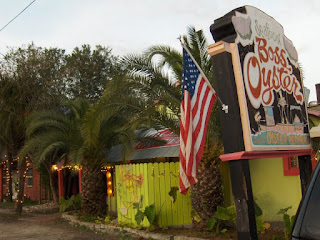Before the development of railways in the Gulf states, Apalachicola was the third busiest port in the Gulf of Mexico. In the late 19th century and early 20th century, the sponge trade, led by Greek immigrants, was a major industry in the town.
Apalachicola is still the home port for a variety of seafood workers, including oyster harvesters and shrimpers. More than 90% of Florida's oyster production is harvested from Apalachicola Bay.
Morning comes gently to Apalachicola. Oyster boats and shrimpboats begin their daily pilgrimages into the seafood-rich bay as the sun rises on the Northwest Florida coast.
The lights twinkle on in this fishing village, its residents ready for another day in unspoiled paradise. If you ever wondered if such a place still exists, yes, old Florida lives here. A lone blinking yellow light directs the downtown traffic.
There is one word that describes Apalachicola, and that is laid back. We tied up to a face dock next to an abandoned, turn of the century building in front of a seafood plant and shrimp boats.
We would walk out to the street and picture bustling seafood houses, weather-worn shrimp boats and stately brick buildings that once served as 19th century chandleries, net factories and warehouses.
The pink bird pictures are for my friend, Jody (the lover of all flamingos).
Eclectic boutiques, galleries and restaurants are tucked into nooks and crannies throughout the historic downtown commercial district.
Of course we had our own transportation.
And don't forget the seafood at Boss Oysters!
The town features meticulously restored hotels and B&Bs as well as luxury waterfront accommodations. Looking for a treasure to take home? Spend time browsing through unique galleries, stores and antique shops.
Apalachicola’s history and maritime culture are matched by the area’s bountiful natural resources.
The Apalachicola River and Apalachicola Bay provide great fishing opportunities for both fresh and salt water fishing buffs.
Apalachicola’s maritime culture is best reflected along its working waterfront.
You’ll feel history when you breathe the salty air of Apalachicola Bay and walk the canopy-shaded sidewalks of Apalachicola’s distinguished Historic District replete with the regal homes of past sea captains, river pilots and sponge divers.
Apalachicola's diverse and colorful past remains visible today as you stroll along the wide tree-lined streets where picturesque Victorian homes display the charm of years gone by.
Apalachicola echoes with memories of an era once filled with steamboats and schooners, railroads and lumber mills. The cemetery was filled with stories of shipwrecks and plagues, whole families dying of yellow fever.
A walk through Chestnut Cemetery is in reality a remarkable walk back
through time. Key figures of Southern history are buried there
and the inscriptions on the tombs of others whose names have been
forgotten illuminate the past.
We found Paradise Lost in the Florida Panhandle. Who knew?


























No comments:
Post a Comment